#Centrosaurinae
Explore tagged Tumblr posts
Text

Why not start a new month of the year with a newly-discovered dinosaur species? Meet Lokiceratops rangiformis, a fantastic exemplar of the rich ceratopsian diversity in Laramidia during the Campanian stage of the Late Cretaceous. A 6-meter-long centrosaurine ceratopsian with a 2-meter-long skull, it lived about 78.1 million years ago in what is now Montana’s Judith River Formation and appears to be most closely related to the slightly-younger Medusacertops lokii from the same formation and Albertaceratops nesmoi from Alberta’s Oldman Formation. The three species all together constitute the newly-created subgroup Albertaceratopsini within the Centrosaurinae.
#paleoart#dinosaur#dinosaurs#paleontology#ceratopsidae#ceratopsians#ceratopsian#lokiceratops#centrosaurinae#dinosaur artwork#dinosaur art#late cretaceous#palaeontology#paleoillustration#paleoblr#palaeoblr#paleoartists on tumblr#dinosauria#cretaceous#cretaceous period
267 notes
·
View notes
Text

Lokiceratops rangiformis was a ceratopsian dinosaur that lived during the Late Cretaceous (~78 million years ago) in what is now Montana, USA. Estimated at about 6.7m long (~22ft), it was one of the largest known members of the centrosaurine branch of the ceratopsians.
It had a unique arrangement of ornamentation on its skull, with no nose horn, two long brow horns, and a pair of huge asymmetrical curving blade-like spikes on the top of its square frill – some of the largest known frill spikes of any ceratopsian.
It lived in a swampy environment near the shore of the Western Interior Seaway, in an area that seems to have had an unusually high diversity of ceratopsians – along with Lokiceratops there were three other centrosaurines (Medusaceratops, Albertaceratops, and Wendiceratops), and one chasmosaurine (Judiceratops).
(There's also a possibility that it might not actually be a unique species. We know some other ceratopsians' faces changed quite drastically as they aged, so Lokiceratops could instead represent a fully mature individual of Medusaceratops.)
———
NixIllustration.com | Tumblr | Patreon
References:
Gramling, Carolyn. "Meet Lokiceratops, a newly discovered species of horned dinosaur." Science News, 20 June 2024, https://www.sciencenews.org/article/lokiceratops-new-species-horned-dinosaur
Loewen, Mark A., et al. "Lokiceratops rangiformis gen. et sp. nov.(Ceratopsidae: Centrosaurinae) from the Campanian Judith River Formation of Montana reveals rapid regional radiations and extreme endemism within centrosaurine dinosaurs." PeerJ 12 (2024): e17224. https://doi.org/10.7717/peerj.17224
Molinek, Rudy. “Dinosaur with Giant, Loki-like Horns Has the ‘craziest, Coolest’ Headgear-and Could Be a New Species.” Smithsonian Magazine, 20 June 2024, https://www.smithsonianmag.com/smart-news/dinosaur-with-giant-loki-like-horns-has-the-craziest-coolest-headgear-and-could-be-a-new-species-180984577/
Wikipedia contributors. “Lokiceratops.” Wikipedia, 1 Jul. 2024, https://en.wikipedia.org/wiki/Lokiceratops
#science illustration#paleontology#paleoart#palaeoblr#lokiceratops#centrosaurinae#ceratopsidae#ceratopsian#marginocephalia#ornithischia#dinosaur#art
358 notes
·
View notes
Text
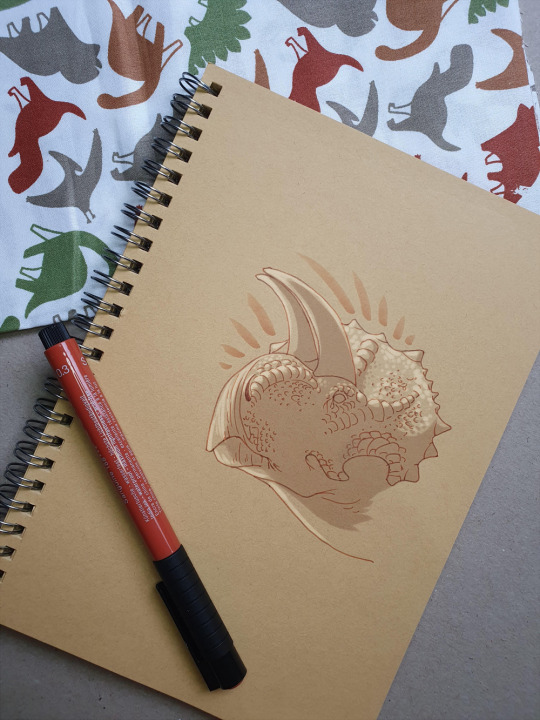
Day 2: Furcatoceratops elucidans
#paleoart#art#dinosaur#prehistoric#paleontology#digitalart#traditionalart#Archovember2023#Dinovember#Dinovember2023#DrawDinovember#DrawDinovember2023#Furcatoceratopselucidans#Furcatoceratops#Nasutoceratopsini#Centrosaurinae#Ceratopsia#archovember#palaeontology
61 notes
·
View notes
Text

Another late cretaceous dino, Centrosaurus! Their central horn could curve backwards or forward, which gave them some cool variation!
#paleoart#dinosuar#dino art#centrosaurus#late cretaceous#ceratopsidae#centrosaurinae#animals#stagart
116 notes
·
View notes
Text

Day 2: Avaceratops lammersi crossing the streams by splash running.
Happy 4th of July.
#my art#dinosaur#paleoart#dinosaurs#myart#dinosauria#sketchbookapp#Judith River July#avaceratops#centrosaurinae#ceratopsidae#ceratopsia#ornithischia
27 notes
·
View notes
Text
Lokiceratops rangiformis Loewen et al., 2024 (new genus and species)
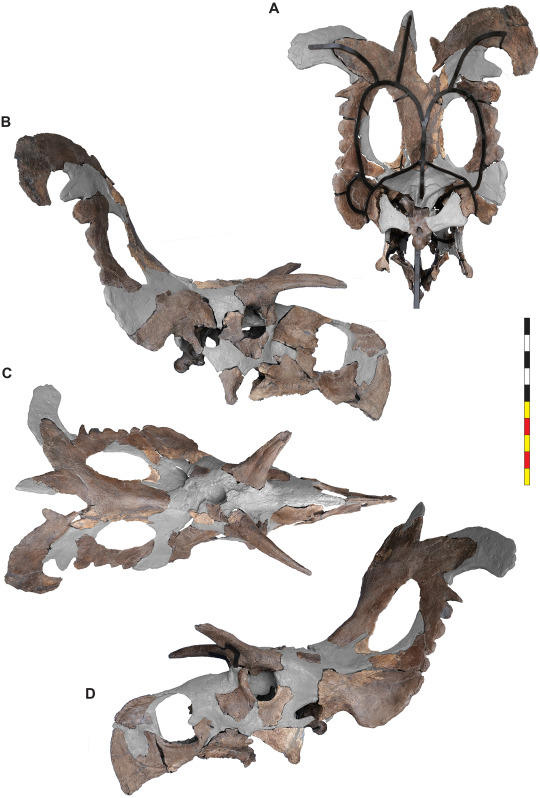
(Reconstructed skull of Lokiceratops rangiformis [scale bar = 1 m], with unpreserved portions in gray, from Loewen et al., 2024)
Meaning of name: Lokiceratops = [Norse deity] Loki's horned face [in Greek]; rangiformis = Rangifer [genus of the extant reindeer]-shaped [in Latin]
Age: Late Cretaceous (Campanian), roughly 78.1 million years ago
Where found: Judith River Formation, Montana, U.S.A.
How much is known: Partial skeleton of one individual, including a partial skull, several vertebrae, and some limb bones.
Notes: Lokiceratops was a centrosaurine cereratopsian, making it a horned dinosaur more closely related to Styracosaurus and Pachyrhinosaurus than to Triceratops. It is one of the largest known centrosaurines, with its skull alone being nearly 2 m long.
The skull of Lokiceratops was highly distinctive. A pair of very large, curved horns at the back of its frill pointed out to the sides. Furthermore, a pair of smaller horns closer to the center of the frill was asymmetrical, with one horn being larger than the other. Asymmetrical head ornamentation is also seen in the antlers of reindeer, hence the species name "rangiformis".
Lokiceratops is known from approximately the same time and location as three other centrosaurines, Albertaceratops, Medusaceratops, and Wendiceratops. Despite their diversity, all centrosaurines discovered so far are only known from very narrow ranges in both time and space. This may suggest that these horned dinosaurs diversified rapidly into numerous forms differentiated primarily by display features such as the shape of their horns and frills, with each species lasting only a short time in a small geographic region before evolving into new species or going extinct.
Reference: Loewen, M.A., J.J.W. Sertich, S. Sampson, J.K. O’Connor, S. Carpenter, B. Sisson, A. Øhlenschlæger, A.A. Farke, P.J. Makovicky, N. Longrich, and D.C. Evans. 2024. Lokiceratops rangiformis gen. et sp. nov. (Ceratopsidae: Centrosaurinae) from the Campanian Judith River Formation of Montana reveals rapid regional radiations and extreme endemism within centrosaurine dinosaurs. PeerJ 12: e17224. doi: 10.7717/peerj.17224
420 notes
·
View notes
Text
23 notes
·
View notes
Text
also I'm sorry for forgetting elasmarians in ornithopods I promise to include them in the misc one
#dinosaurs#palaeoblr#prehistoric life#polls#marginocephalians#ceratopsians#pachycephalosaurs#triceratops#styracosaurus#protoceratops#psittacosaurus#pachycephalosaurus#et al
195 notes
·
View notes
Text
youtube
Welcome to the Juras-Sick Park-Cast podcast, the Jurassic Park podcast about Michael Crichton's 1990 novel Jurassic Park, and also not about that, too.
Find the episode webpage at: Episode 67 - The Encased Mosquito.
In this episode (stream is here!), my terrific guest Dr. Mark A. Loewen joins the show to chat with me about:
the formation of the Rocky Mountains, Laramidia and its connection to Pangea, how Tyrannosaurs and Triceratops benefited from the climatic and geographic changes of the Late Cretaceous, and the new paper on Lokiceratops rangiformis; its discovery, its purchase and new home in Denmark at the Museum of Evolution in Denmark, hyperdiversity of macroherbivorous dinosaurs endemic to particular areas in Larimidia, finding artists to portray the animal, naming new dinosaurs, declaring a new clade albertaceratopsini, naming conventions, centrosaurs in Jurassic Park like styracosaurus, nasutoceratops and sinoceratops, the differences between chasmosaurs and centrosaurs, thinking of dinosaurs like centorsaurines as if they were birds, and how the large cavities in ceratopsian skulls may have impacted their lives, centrosaurine chewing, reverse engineering a chicken, and much more!
Plus dinosaur news about:
Diuqin lechiguanae gen. et sp. nov., a new unenlagiine (Theropoda: Paraves) from the Bajo de la Carpa Formation (Neuquén Group, Upper Cretaceous) of Neuquén Province, Patagonia, Argentina. (Diuqin lechiguanae)
Lokiceratops rangiformis gen. et sp. nov. (Ceratopsidae: Centrosaurinae) from the Campanian Judith River Formation of Montana reveals rapid regional radiations and extreme endemism within centrosaurine dinosaurs. (Lokiceratops rangiformis)




Featuring the music of Snale https://snalerock.bandcamp.com/
Intro: Sally Ride, and the Outro: Latebloomer.


The Text:
This week’s subject is a little review of Loy's Procedure, used as a back-up plan for extracting dinosaur DNA at Jurassic Park.
Jurassic Park (1993): Sc. 2 "The Encased Mosquito."
Corrections:
Side effects:
May cause you to try and teach a ceratopsian to chew gum.
Find it on iTunes, on Spotify (click here!) or on Podbean (click here).
Thank you!
The Jura-Sick Park-cast is a part of the Spring Chickens banner of amateur intellectual properties including the Spring Chickens funny pages, Tomb of the Undead graphic novel, the Second Lapse graphic novelettes, The Infantry, and the worst of it all, the King St. Capers.
You can find links to all that baggage in the show notes, or by visiting the schickens.blogpost.com or finding us on Facebook, at Facebook.com/SpringChickenCapers or on Youtube by searching for the “Juras-Sick Park-Cast podcast” or on Tumblr @misterrogers22 or on X at @RogersRyan22 or email me at ryansrogers-at-gmail.com.
You can find links to all that baggage in the show notes, or by visiting the schickens.blogpost.ca or finding us on Facebook, at Facebook.com/SpringChickenCapers or on Youtube by searching for the “Juras-Sick Park-Cast podcast” or on Tumblr @misterrogers22 or on twitter at @RogersRyan22
Thank you, dearly, for tuning in to the Juras-Sick Park-Cast, the Jurassic Park podcast where we talk about the novel Jurassic Park, and also not that, too. Until next time!
#jurassic park#dinosaurs#youtube#michael crichton#dinosaur movies#podcast#paleoart#paleontology#Lokiceratops#Diuqin#unenlagiine#centrosaurine#Mark A. Loewen#interview#Michael Crichton#Steven Spielberg#david koepp#Youtube
2 notes
·
View notes
Note
Grid Color theory + Batshit Dinosaur(s and friends) Cladistics Thyreophora (Stegosaurs & Ankylosaurs): Very varied in color, becomes warmer in color towards the heart of the grid. Coelurosauria (Velociraptor, Tyrannosaurus, Gallimimus, Therizinosaurus, Oviraptor, Stenonychosaurus{Troodon}, Yi, and birds): Fairly warm colored, though begins to cool down in Dromaeosauridae (Velociraptor, Microraptor, and their cousins!) Ceratopsians (Triceratops and its cousins): very cool colored except for Dino Charge but pink was a one off there. Warmer in centrosaurinae cough cough shoehorns in fan season cough cough
Carnosauria (Spinosaurus, Allosaurus, Megalosaurus and friends): what the fuck is happening in the beginning, but at least its warmer around Carcharodontosauridae? cough cough shoehorns in fan season AGAIN cough cough Pterosauria: Warm...ish... Plesiosauria: Cool colored. Mosasauroidea: The fuck is happening???

...I'm just going to differ to you because, truly, if the dinosaurs aren't the ones from MMPR, I don't know enough about them to give an opinion.
#boom! comics power rangers#the only other ones I know vaguely about are the changyuraptor#that's it
4 notes
·
View notes
Text
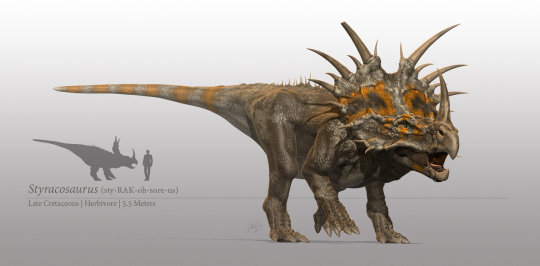
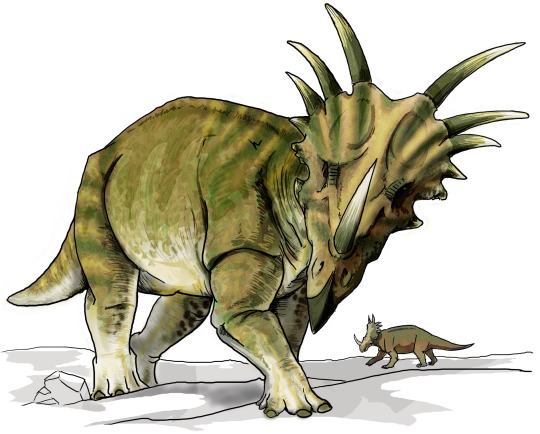
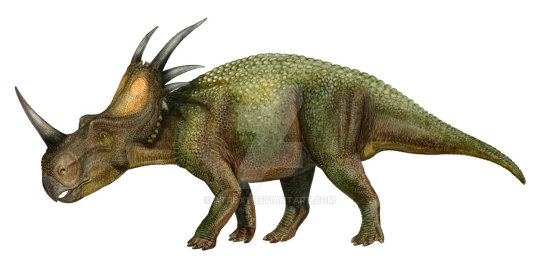
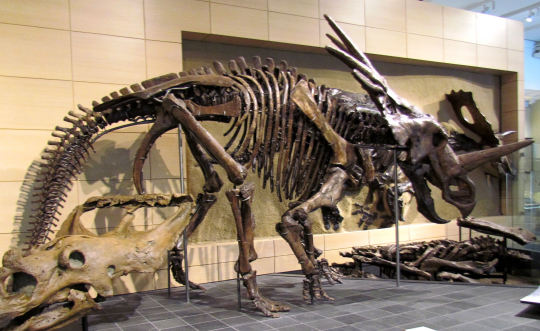
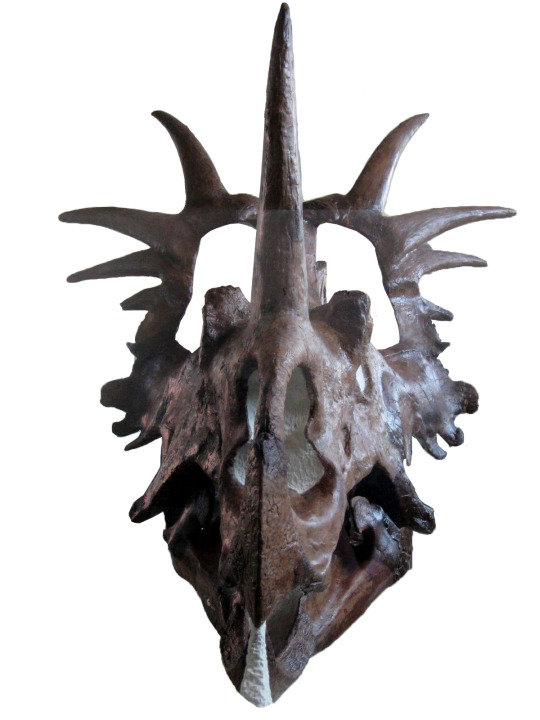
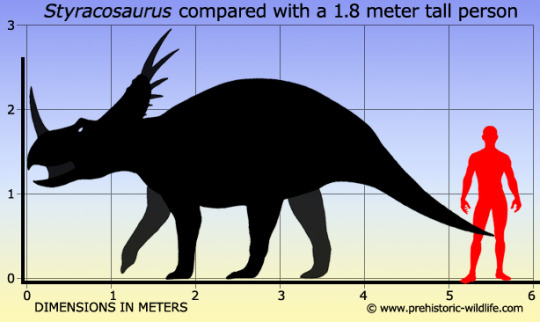
Styracosaurus
(temporal range: 75.5-74.5 mio. years ago)
[text from the Wikipedia article, see also link above]
Styracosaurus (/stɪˌrækəˈsɔːrəs/ sti-RAK-ə-SOR-əs; meaning "spiked lizard" from the Ancient Greek styrax/στύραξ "spike at the butt-end of a spear-shaft" and sauros/σαῦρος "lizard")[1] is a genus of herbivorous ceratopsian dinosaur from the Cretaceous Period (Campanian stage), about 75.5 to 74.5 million years ago. It had four to six long parietal spikes extending from its neck frill, a smaller jugal horn on each of its cheeks, and a single horn protruding from its nose, which may have been up to 60 centimeters (2 feet) long and 15 centimeters (6 inches) wide. The function or functions of the horns and frills have been debated for many years.
Styracosaurus was a relatively large dinosaur, reaching lengths of 5–5.5 metres (16–18 ft) and weighing about 1.8–2.7 metric tons (2.0–3.0 short tons). It stood about 1.8 meters (5.9 feet) tall. Styracosaurus possessed four short legs and a bulky body. Its tail was rather short. The skull had a beak and shearing cheek teeth arranged in continuous dental batteries, suggesting that the animal sliced up plants. Like other ceratopsians, this dinosaur may have been a herd animal, travelling in large groups, as suggested by bone beds.
Named by Lawrence Lambe in 1913, Styracosaurus is a member of the Centrosaurinae. One species, S. albertensis, is currently assigned to Styracosaurus. Another species, S. ovatus, named in 1930 by Charles Gilmore was reassigned to a new genus, Rubeosaurus, by Andrew McDonald and Jack Horner in 2010,[2] but it has been considered either its own species or a species of Styracosaurus (or even a specimen of S. albertensis)[3] again, since 2020.
9 notes
·
View notes
Text
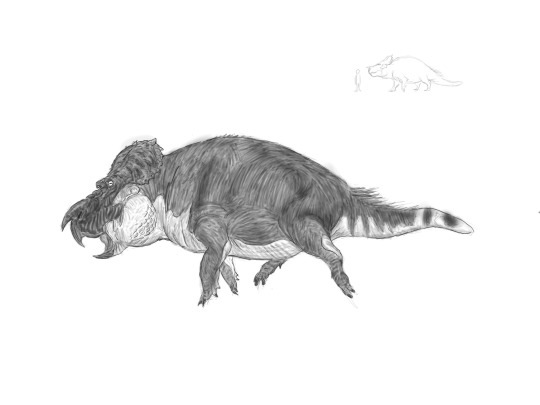
Aurungo-Pundapi (artwork by Yuujinner)
Kingdom: Animalia Phylum: Chordata Class/Clade: Reptilia (Sauropsida) Clade: Diapsida Clade: Archosauria Clade: Dinosauria
Order: Ornithischia
Clade: Marginocephalia
Suborder: Ceratopsia
Family: Ceratopsidae
Subfamily: Centrosaurinae
Clade: Eucentrosaura
Tribe: Centrosaurini
Genus: Deinoceratops
Species: D. susoides (”pig-like terrible horned face”)
Ancestral species: Centrosaurus apertus
Time period: Pleistocene to modern day (1.5 million years to present).
Information:
In the eastern swamps of the Isle of Perils, we encounter a most bizarre species: Deinoceratops susoides (“pig-like terrible horned face”), better known by its Xenogaean name, the aurungo-pundapi, “the one whose face is adorned with scars”.
A centrosaurine ceratopsid, the aurungo-pundapi is unusual not only in its semiaquatic habits, not unlike those of a hippopotamus, but also its diet: an omnivore, this creature eats mostly aquatic vegetation like reeds and lilies, but it also eats, among other things, carrion, fish, and the young of other dinosaurs, and it may even go after small crocodylomorphs in its habitat. Of course, as an animal which shared its habitat with other large meat-eaters, including rhizodonts and theropods many times larger than it, the aurungo-pundapi is quite territorial: this animal will usually rush at attackers first and ask questions later, and it is so widely-feared for its ferocious temper, that early European explorers in the region dubbed it the “lizard-hippo” in reference to its similar size, niche, and temperament to its namesake. However, unlike the hippopotamus of Africa, the aurungo-pundapi’s aggression frequently extends to its own species to the point where no two animals will ever congregate within the same stretch of water outside of the mating season. During late June and throughout early July, the males are at their most aggressive: during this time, they enter a state similar to musth in male elephants wherein their hormones spike, causing them to become highly aggressive towards other animals. It was during one such mating season in 1938 that a bull aurungo-pundapi went on a rampage in a village in the marshlands, killing many livestock and people alike before it was finally shot and killed by the villagers. As this animal’s bulk (which is actually comprised mostly of lean muscle instead of fat) makes it difficult for this animal to move efficiently on land, mating usually occurs in the water, which is made possible thanks to the animal’s ability to hold its breath for nearly 2 hours at a time. After the pair have mated, they go separate ways and in a few weeks time, the female will lay her clutch of around 4-8 eggs in a small nest on land which she will visit regularly, removing and adding dirt regularly as needed. In another month, the young will hatch, and for the first few years of their life, they will be dependent on her for protection until they are big enough to fend for themselves, after which she will chase them off. By age 10, they will have reached full size and by age 14, they will have reached sexual maturity, and by this point in their life, few predators will ever dare to harm them. Thus, a healthy aurungo-pundapi can expect to live to a ripe old age of 60-70 years.
This is a revamped version of an old, old creature!
#speculative evolution#novella#fantasy#scifi#scififantasy#speculative biology#speculative fiction#speculative zoology#worldbuilding#dinosaur#ceratopsian#ceratopsia#ornithischians#fantasy creature#sci fi creature#archosaur#spec evo#creature design#creature art#sci-fi creature
4 notes
·
View notes
Text

Strange Symmetries #17: Spiky Surprise
Styracosaurus albertensis was a ceratopsid dinosaur living during the late Cretaceous about 75 million years ago, in what is now Alberta, Canada. Around 5m long (~16'), it was one of the most elaborately ornamented horned dinosaurs, with a long nose horn and multiple elongated spikes on its frill.
There was actually quite a lot of variation in the frills of Styracosaurus, with varying numbers of long spikes and extra hook-like projections present on some individuals. But one recently-discovered specimen nicknamed "Hannah" is especially surprising – it had a noticeable amount of asymmetry in its skull. The left and right sides show different numbers and arrangements of spikes, so much so that if the two halves had been discovered separately they might have been identified as belonging to two completely different species.
Frill arrangements are often used to define different ceratopsids, so if this level of individual variation and asymmetry existed in other species, too, then we may need to reevaluate some of them.
———
NixIllustration.com | Tumblr | Twitter | Patreon
#science illustration#strange symmetries#paleontology#paleoart#palaeoblr#styracosaurus#centrosaurinae#ceratopsid#ceratopsia#marginocephalia#ornithischia#dinosaur#art
490 notes
·
View notes
Text

Pachyrhinosaurus (Arti dalam bahasa Yunani "kadal berhidung tebal" dari Παχυ (pachy), tebal; ρινό (rinó), hidung; dan σαυρος (sauros), kadal)[1] merupakan genus dinosaurus ceratopsid centrosaurinae dari Zaman Kapur akhir dari Amerika Utara. Contoh pertama ditemukan oleh Charles M. Sternberg di Alberta, Kanada, pada tahun 1946, dan dinamai pada tahun 1950. Lebih dari selusin tengkorak parsial dan berbagai macam fosil lainnya dari berbagai spesies ditemukan di Alberta dan Alaska. Jumlah yang besar tidak tersedia untuk studi hingga tahun 80-an, menghasilkan peningkatan minat yang baru pada Pachyrhinosaurus
0 notes
Text
Lokiceratops rangiformis fossil is 78 million years old
Lokiceratops rangiformis is an evolutionary cousin to the Triceratops being part of a clade called Centrosaurinae. Centrosaurinae are horned dinosaurs. Located in the island continent Laramidia
1 note
·
View note
